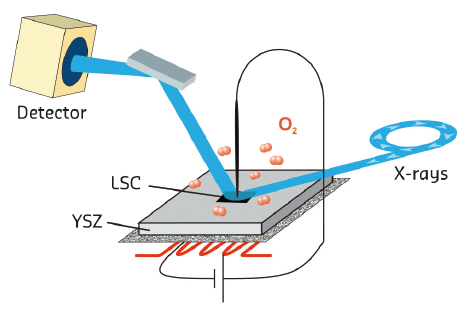- Home
- Users & Science
- Scientific Documentation
- ESRF Highlights
- ESRF Highlights 2016
- Complex systems and biomedical sciences
- Operando study of electrode/electrolyte interfaces in solid oxide fuel cells
Operando study of electrode/electrolyte interfaces in solid oxide fuel cells
Solid oxide fuel cells have the potential to provide green energy in the future. These cells produce electricity by burning fuel without combustion and, depending on the initial reactants, with a minimum of hazardous products. By operando interface diffraction, the buried region between the fuel cell's cathode and the electrolyte was investigated. The electrolyte surface region was found to change composition and develop atomic defects during operation. These processes form an additional oxygen diffusion barrier and play a role in the overall performance of fuel cells.
Solid oxide fuel cells (SOFCs) are very promising for the generation of sustainable and renewable power. Despite intense research, SOFC technology has not yet reached widespread commercial success. A more detailed microscopic understanding of the SOFC processes is necessary to tailor their performance and lifetime.
Typically, SOFCs consist of a solid electrolyte, usually yttria-stabilised zirconia, sandwiched between a cathode and an anode. The overall performance depends on many different kinetic processes, of which the cathodic oxygen exchange reaction and oxygen transport through the electrode/electrolyte interface are bottlenecks for SOFC operation. A key target in SOFCs development is to obtain a high ion transport rate at relatively low temperatures. Perovskites are suitable candidate electrode materials for intermediate temperature range (800–1000 K) SOFCs. In this study, the mixed ionic-electronic conductor La1–xSrxCoO3−δ (LSC) was used due to its high oxygen conductivity and fast oxygen surface kinetics. The most widely used electrolyte material is yttria-stabilised zirconia (YSZ) due to its relatively high oxygen diffusion constant and stability. However, these properties depend strongly on the yttria doping level. Our aim was to study the surface segregation properties of YSZ under the influence of temperature, oxygen and cathode material.
 |
|
Fig. 100: Sketch of the experiment. The model SOFC is placed on a heater in an oxygen environment. The sample is polarised by a Pt backside electrode and a sharp Pt tip. An analyser crystal is used to reduce the fluorescent background reaching the detector. |
By the use of anomalous surface X-ray diffraction (SXRD), it is possible to determine the interface composition and structure of YSZ(100) buried under the LSC microelectrode. At non-anomalous X-ray energies, the scattering of Y and Zr is practically indistinguishable. The experiment was performed at beamline ID03 using a microfocused X-ray beam. This challenging experiment (Figure 100) allowed us to resolve the complete 3D interfacial structure and composition with subatomic resolution. To mimic the transport processes as they occur in a real fuel cell, we polarised the polycrystalline LSC microelectrode with respect to a porous Pt counter electrode below the single crystal YSZ(100) electrolyte under an oxygen atmosphere at elevated temperatures. Depending on the polarisation direction, inward or outward oxygen ion transport is controlled. The structural information was extracted from crystal truncation rods (CTRs) that originated from the polished YSZ single crystal surface buried under the electrode.
The X-ray energy was precisely tuned to the Y and Zr absorption edges, thereby varying the scattering contrast between the two elements and retrieving the layer-wise composition, disclosing information about the occupancy profiles (Figure 101).
 |
|
Fig. 101: Occupancy profiles of the first three atomic bilayers of the YSZ (100) electrolyte under various conditions. Shown are Y (green), Zr (blue) and O (red). |
The results reveal that the Y cation occupancy at the electrode/electrolyte interface strongly depends on the conditions such as the applied potential. The interface was found to be Y rich after LSC film deposition; subsequent exposure to oxygen in the mbar pressure regime at 775 K strongly reduced the Y concentration at the interface, which is traced back to the complex defect chemistry and thermodynamics of LSC in contact with YSZ. Upon bias voltage application, further changes were observed, indicating enhanced Y concentration at the interface for positive bias which is expected to be detrimental for the oxygen ion transport through the interface. Further evidence for Y segregation is found by outward cation interfacial relaxation, which can be explained by considering that Y has a larger ionic radius than Zr. The LSC/YSZ(100) interface was found to stay atomically smooth under oxygen transport conditions.
This atomic-scale information is an important input towards a microscopic understanding of the processes occurring at the cells’ buried interfaces and it is instrumental in the design of next generation SOFCs.
Principal publication and authors
Operando X-ray investigation of electrode/electrolyte interfaces in model solid oxide fuel cells, S. Volkov (a,b), V. Vonk (a), N. Khorshidi (c), D. Franz (a, b), M. Kubicek (d), V. Kilic (e), R. Felici (f), T.M. Huber (d), E. Navickas (d), G.M. Rupp (d), J. Fleig (d) and A. Stierle (a,b), Chem. Mater 28, 3727–3733 (2016);
doi: 10.1021/acs.chemmater.6b00351.
(a) Deutsches Elektronen-Synchrotron DESY, Hamburg (Germany)
(b) Fachbereich Physik, Universität Hamburg (Germany)
(c) Max-Planck-Institut für Intelligente Systeme, Stuttgart (Germany)
(d) Institute of Chemical Technologies and Analytics, Vienna University of Technology (Austria)
(e) Universität Siegen (Germany)
(f) ESRF



